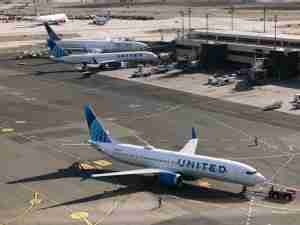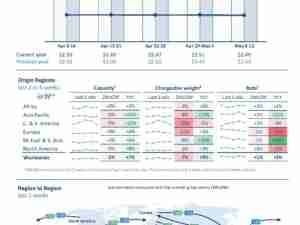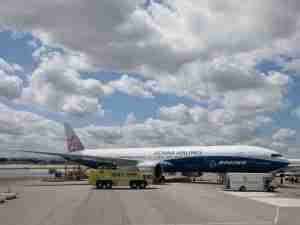Fitch Ratings has affirmed the ratings on the following large airports and major airline hub facilities; however, the Rating Outlook has been revised to Negative from Stable:
• Charlotte Douglas International Airport, NC (CLT) 'AA-' rating on its general airport revenue bonds issued by the City of Charlotte;
• Chicago Midway International Airport, IL (MDW) 'A' rating second-lien lien revenue bonds;
• Dallas Love Field Airport, TX (DAL) 'A' rating senior lien airport revenue bonds issued by Love Field Modernization Corp.;
• Denver International Airport, CO (DEN) 'AA-' and 'A+' ratings on the senior lien and subordinate lien general airport revenue bonds, respectively;
• Detroit International Airport, MI (DTW) 'A' ratings on both the senior lien and junior lien airport system revenue bonds issued by Wayne County Airport Authority;
• State of Hawaii Department of Transportation, HI 'A+' and 'A' ratings on the airport system revenue bonds and certificates of participation, respectively;
• Minneapolis-St. Paul Metropolitan Airports Commission, MN (MSP) 'AA-' and 'A+' ratings on the senior lien and subordinate lien revenue bonds, respectively;
• Philadelphia International Airport, PA (PHL) 'A' rating on the airport revenue bonds;
• Tampa International Airport, FL (TPA) 'AA-' and 'A+' ratings on the senior lien and subordinate lien airport revenue bonds, respectively , issued by Hillsborough County Aviation Authority.
Fitch Ratings has affirmed the ratings on the following large U.S. airports but revised the Rating Outlook to Negative from Positive:
• Houston Airport System, TX (IAH and HOU) 'A' rating on the subordinate lien revenue bonds;
• Greater Orlando Aviation Authority, FL (MCO) 'AA-' and 'A+' ratings on the senior lien and subordinate lien revenue bonds, respectively.
RATING RATIONALE
The recent outbreak of coronavirus and related government containment measures worldwide creates an uncertain global environment for air travel in the near term. While the above airport issuers performance data through most recently available issuer data may not have indicated impairment, material changes in revenue and cost profile are occurring across the sector and likely to worsen in the coming weeks and months as economic activity suffers and government restrictions are maintained or expanded. Fitch's ratings are forward-looking in nature, and Fitch will monitor developments in the sector as a result of the virus outbreak as it relates to severity and duration, and incorporate revised base and rating case qualitative and quantitative inputs based on expectations for future performance and assessment of key risks.
Large Airports and Major Airline Hubs Rating Actions.
The negative rating outlook actions assigned to the above airport credits serving large U.S. markets reflects the current stressed environment in aviation, affecting origination-destination as well as connecting travel. Severe declines in enplaned passenger traffic will affect operating revenues across all of these airports, with the greatest impacts to occur in the second quarter of 2020 and potentially extend into future periods due to the coronavirus pandemic. These airports have strong franchise positions as major market destinations and hub facilities but still operate with a moderate- to high-level of dependence on operations from leading carriers. In the near-term, Fitch has assessed that for each of the airports above, the unrestricted cash reserves alone are sufficient to meet debt service due through the end of the current calendar year.
The drop in air travel is likely to be steeper than what was seen during prior global event episodes such as SARS and September 11 terrorist attacks, and the start of the recovery period is difficult to assess as the virus spread is still growing in regions where air travel is most prevalent. Conditions are constantly changing given the fast moving nature of events, and U.S. airports are facing significant reductions in passenger traffic under this environment.
Fitch expects the dramatic reduction in air travel levels to increase financial pressure on all U.S. airports at varying levels, a sector that has had a decade long stretch of traffic expansion and financial stability. The unprecedented requests in recent days for assistance from the federal government by both the air carriers and the airports are indicative of the mutual strains suffered in the aviation industry and demonstrate a clear signal of the present financial pressures. Robust liquidity across most airports, evident through a combination of cash funded bond reserves and additional accounts with unencumbered funds, should provide additional protection to cover upcoming bond payments and is viewed as a mitigating consideration.
Fitch also expects airport management to initiate a number of self-protective actions to preserve their fiscal postures although there are limitations given the broad impairment to the general economy and the industries tied to the aviation sector. Airline agreements in most cases are structured to provide mechanisms to revise airline payment levels in case of large variances to budgeted performance; however, the airlines themselves are financially constrained to the point this approach is not anticipated. Further analysis will follow in the weeks to come with detailed analyses of management reactions and responses, as well as incoming data on traffic, revenues, and expense control actions. In the longer-term, Fitch will analyze traffic and revenue impacts caused by possible changes in air travel patterns.
Fitch conducted a rating case and a sensitivity case to the above credits to assess coverage and liquidity. The rating case scenario, which contemplates airport enplanement declines of approximately 35% in calendar year 2020 relative to 2019 actual levels based on the following assumptions of quarterly traffic activity: 1Q20 (-15% domestic and international)), 2Q20 (-60% domestic and -80% international); 3Q20 (-40% domestic and -50% international) and 4Q20 (-20% domestic and -25% international). For calendar years 2021 and 2022, Fitch assumes 95% and 100% recoveries relative to 2019 levels. Recognizing there are different fiscal year periods for each airport, the assumed traffic levels will be accordingly adjusted. A more severe sensitivity case assumes traffic declines continue at the same peak traffic loss of 2Q20 for an additional quarterly period followed by recoveries that are similar to the rating case. The results of these scenarios will be published as a Ratings Scorecard.
KEY RATING DRIVERS
See links below to individual issuer Rating Action Commentaries with individual Key Rating Driver assessment scores and analysis
RATING SENSITIVITIES
Developments That May, Individually or Collectively, Lead to Positive Rating Action:
--A positive rating action is not expected in the near future. However, a return to a stable outlook could be possible, and the ratings affirmed, if Fitch sees sustained recovery in traffic and revenues due to the easing of the pandemic resulting in normal air traffic patterns or the adaption of strategies that convincingly stabilizes the finances.
Developments That May, Individually or Collectively, Lead to Negative Rating Action:
--A continued period of material traffic declines that presents further challenges to stabilize the finances of the affected airports;
--Further credit erosion of the major air carriers or payment delinquencies to the airports.
--Sustained deterioration in airport liquidity levels.
BEST/WORST CASE RATING SCENARIO
Ratings of Public Finance issuers have a best-case rating upgrade scenario (defined as the 99th percentile of rating transitions, measured in a positive direction) of three notches over a three-year rating horizon; and a worst-case rating downgrade scenario (defined as the 99th percentile of rating transitions, measured in a negative direction) of three notches over three years. The complete span of best- and worst-case scenario credit ratings for all rating categories ranges from 'AAA' to 'D'. Best- and worst-case scenario credit ratings are based on historical performance. For more information about the methodology used to determine sector-specific best- and worst-case scenario credit ratings, please visit https://www.fitchratings.com/site/re/10111579.











